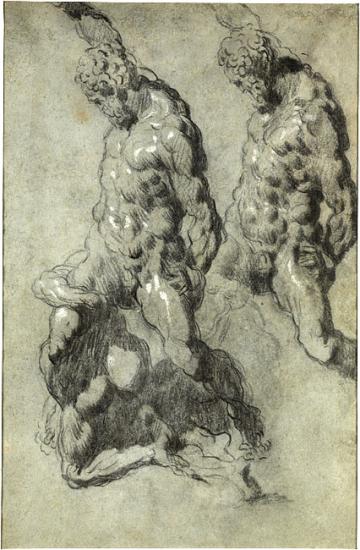
Two Studies of Samson Slaying the Philistines (Judges 15:14–19)
Thaw Collection, 2005
The present sheet is among the more than thirty studies Tintoretto and his workshop produced after a wax or clay replica of Michelangelo's 1528 sculptural model for Samson Slaying the Philistines. The spiraling and radically foreshortened figure of Samson wielding the jawbone of an ass atop one of his victims must have held a particular fascination for the artist, who rose to the challenge of producing a two-dimensional image of the sculpture with admirable skill.
In 1528 the republic of Florence commissioned Michelangelo to create a marble group representing Samson slaying the Philistines. The artist prepared a model but never executed the sculpture. Tintoretto owned a wax or clay model after Michelangelo's design, which is recorded in several drawings by him and members of his workshop. Tintoretto is said to have produced drawings after sculpture and "all good things" throughout his career, including statues by Jacopo Sansovino and casts of sculptures by Michelangelo and Giovanni Bologna.
Tintoretto's characteristic swelling contours and sharp flicks of the chalk heighten the drawing's sense of drama.
Innovations in Drawing
Technical and artistic innovations combined to make Renaissance Venice a vital creative center. Late-fifteenth-century artists generally worked in pen and ink and wash to make relatively finished drawings, but new techniques emerged that enabled them to produce more diverse, and often dramatic, effects. Artists such as Vittore Carpaccio perfected a method of applying ink with a brush onto Venetian blue paper (carta azzurra)—a support greatly prized by Albrecht Dürer. Artists of Titian and Bordone's generation, followed by Tintoretto, preferred a soft black chalk that was ideally suited to record tonal subtleties and create impressions of movement. Jacopo Bassano's innovative use of colored chalks made him a precursor to the pastel tradition. Tintoretto's younger contemporary, Veronese, developed entire compositions with rapid pen sketches while retaining a typically Venetian preoccupation with light.
